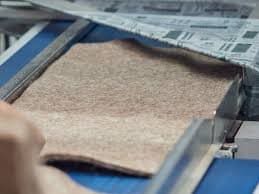Wool packaging could replace plastic for sustainable thermal food packaging
If you order a food produce box, or home meal delivery, chances are it will come in an expanded polystyrene [EPS] box.
Wool, however, is increasingly being used as alternative thermal packaging for food and pharmaceutical products.
Joanne Howarth is the CEO and founder of Planet Protector Packaging, an Australian company creating wool thermal packaging.
“Just as the wool keeps the sheep warm in winter, so too it keeps them cool in summer,” she said.
“Essentially, we’ve leveraged the thermal properties of wool.”
New use for lower quality wool
The product has been made from the various offcuts of a sheep’s fleece, usually discarded, and has then been wrapped in either a recyclable or compostable film.
“It’s not a commercial grade [wool] … it comes from the underbelly of the sheep and it’s coarser, it’s got more modulated fibres,” she said.
“That sort of wool comes more from crossbred sheep.”
For the wool industry, thermal packaging presents another market opening.
Wool Producers Australia CEO, Jo Hall, said the lower quality cuts were usually blended with other types of wool.
“To have a defined use for those sorts of low-quality wools is a really good outcome,” she said.
“We would hope that it would increase demand [of offcuts] and maybe have an impact on price.”
An alternative to plastic packaging?
Wool may seem like a sustainable alternative to plastic packaging but there is some work involved in making it a planet-friendly option.
Rose Read, CEO of the National Waste and Recycling Industry Council [NWRIC], said there were currently no systems to collect and recycle wool, although it is compostable.
“At this stage, those materials either go to landfill or potentially can be used as an energy source,” she said.
“Being a natural fibre, it has durability so perhaps it is something that should be reused a lot more … and that’s where you see it becoming an alternative sustainable packaging.”
If wool fibre cannot currently be recycled, then how does it compare to EPS thermal packaging?
Ms Read said EPS was recyclable but only if clean — which often cut out food packaging.
It could only be recycled if it was collected separately, so usually only by businesses.
“Currently there is no household recycling system for either EPS or wool,” Ms Read said.
“Sustainability applies to a number of factors — if you’re looking at which is more recyclable, then currently there’s more recycling options for EPS than there is for wool, that I’m aware of.
“EPS is often only single use and doesn’t degrade when it gets out into the environment, whereas wool generally is a multi-use item as a material and can biodegrade in the environment, being a natural fibre.
“The issue when making packaging from wool is what are the materials or additives that impact its ability to be composted?”
Ms Read said another factor to consider was the source of the packaging.
“Wool is a more renewable resource … whereas expanded polystyrene is a fossil fuel-based thing which takes millions of years to produce,” she said.
“Sustainability — there are lots of elements to it: renewability, recyclability, and the amount of energy and water it takes to produce that material for its required function.
“Only 12 per cent of plastics overall are recycled.”
How can sustainability be achieved in reality?
Ms Howarth has established a circular economy with the wool packaging where possible.
“[Some clients] can pick up from the customers doorstep the wrapping and the packaging and bring it back, then it is able to go through the whole process yet again,” she said.
“For those clients that aren’t able to recover it, then we work with them on educating the end user … about how they should handle it at the end of life.”
Ms Read said that the NWRIC advocates for produce stewardship.
“That includes those companies that make packaging to take responsibility for not only the environmental impacts in designing, making, and using the packaging, but also what happens at end of life,” she said.

